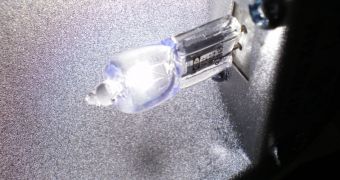Halogen light bulbs are incandescent lamps with construction and operation roughly similar to the classical light bulbs. They are generally much smaller than their 'cousins', have increased lifetimes and are able to produce high light outputs with elevated color temperatures, as opposed to all other types of incandescent lamps.
A halogen lamp is basically made of a tungsten filament encased inside a transparent envelope. The preferred material for the envelope is generally quartz, since glass is unable to sustain the temperature at which the filament operates (up to 2,500 degrees Celsius), while the inert atmosphere is made of a mix of argon and nitrogen, and a small amount of a halogen element, such as iodine or bromine.
Typical incandescent light bulbs have relatively short lifetimes, lasting for only 750 to 1,000 hours of normal use. This is mostly because the high temperature of the filament allows tungsten vapor to escape in the inert atmosphere of the device. Over time, this process will eventually lead to a thinning of the filament, until it will no longer be able to support the electric current being passed through it and it will stop working.
Additionally, incandescent light bulbs are extremely inefficient, converting less than 2.5 percent of the electric energy into light, while the rest is lost through heat. Another common problem with classical light bulbs is that they have low color temperatures.
Halogen lamps, through their special build, are able to bring several improvements in these three issues. Halogens are known to combine with tungsten if the temperature of the medium is sufficiently high. Through this property the generated tungsten vapor is recycled back to the filament rather than simply being deposited on the inner walls of the envelope.
Secondly, by running the filament at a much higher temperature, halogen lamps are able to release more light, reaching efficiency rates as high as 3.5 percent. At the same time the color temperature of the emitted light is increased, getting closer to white, as opposed to the yellowish-white light generated by classical incandescent light bulbs.

 14 DAY TRIAL //
14 DAY TRIAL //